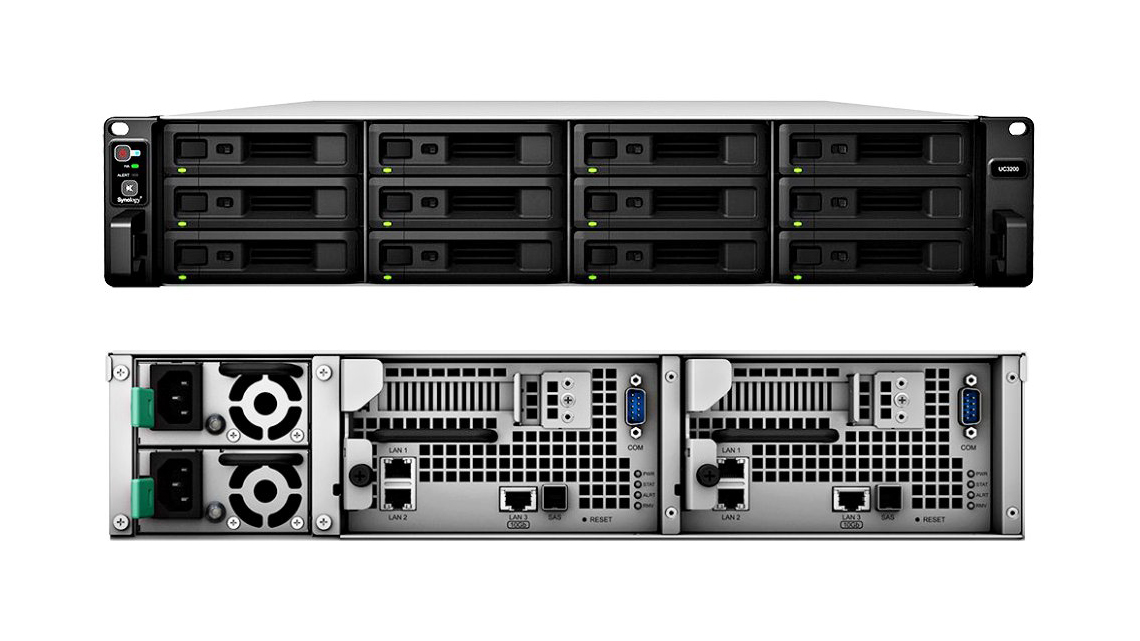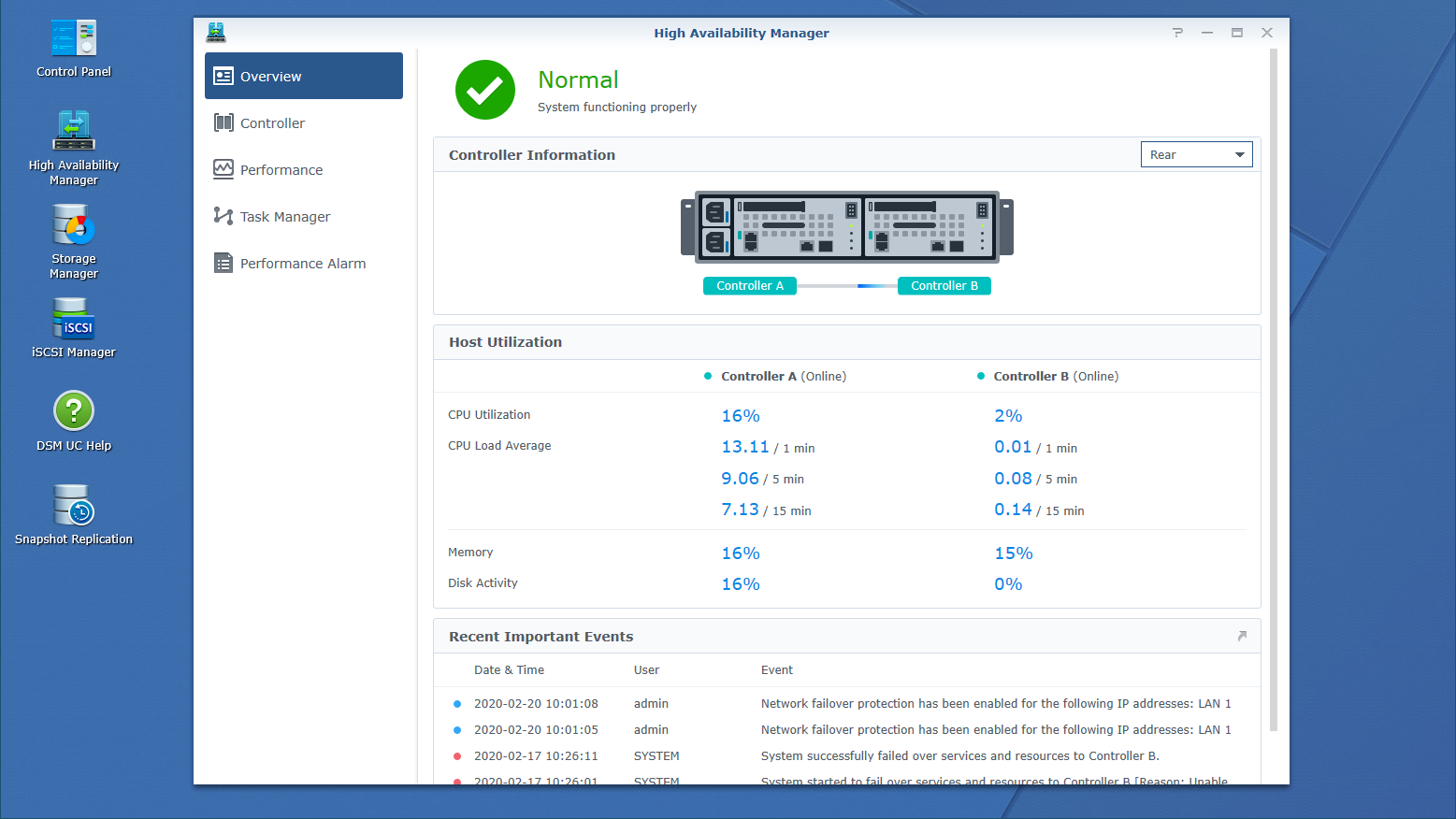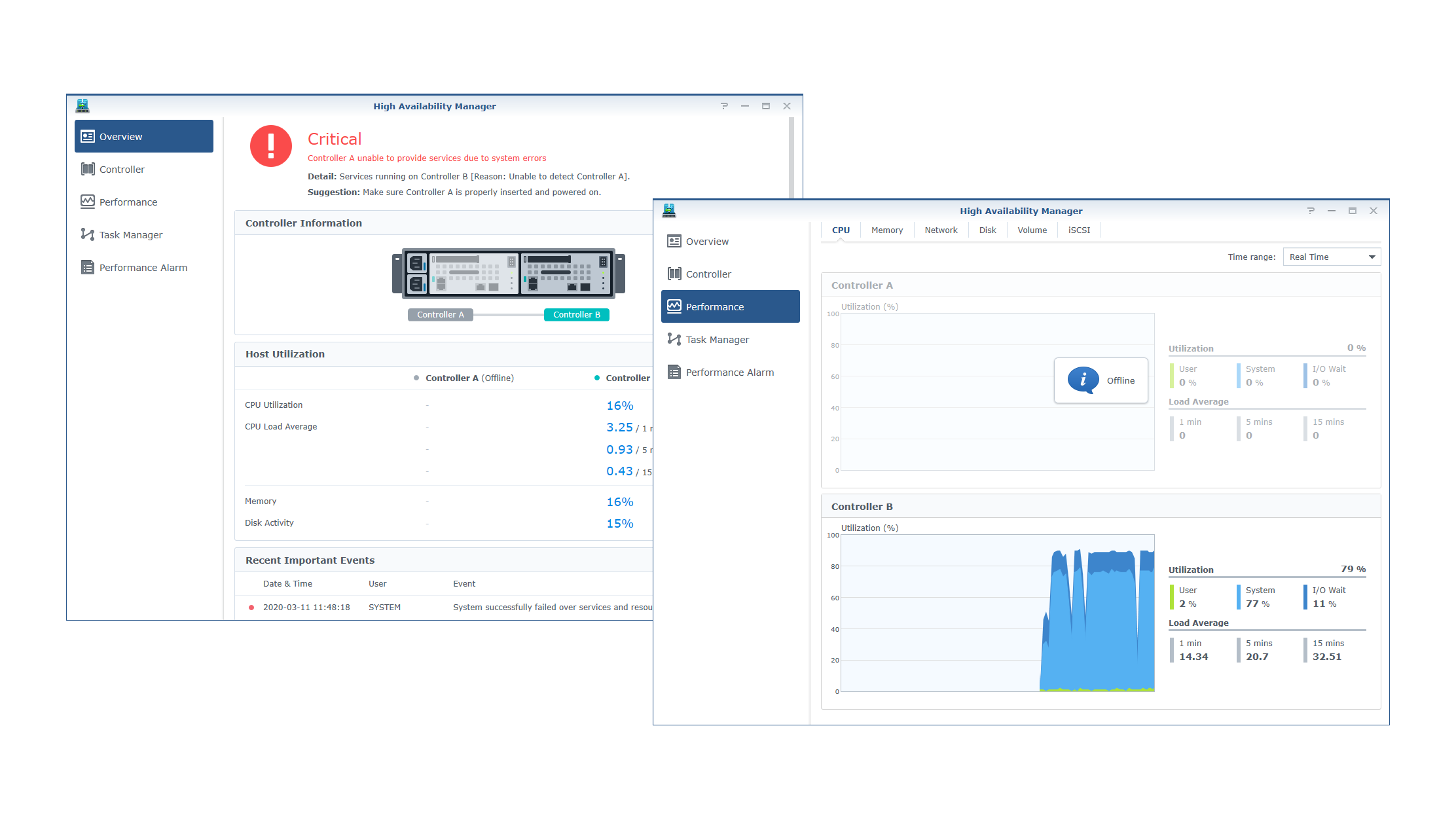Synology UC3200 review: Reliable IP SANs at a rock bottom price
Synology’s first active/active storage array delivers perfect failover


-
+
Top value
-
+
Easy deployment
-
+
Transparent and seamless failover
-
+
Good LUN snapshot and replication services
-
-
Modest random write performance

Synology’s first move into highly available storage was a hit and miss affair; its RC18015xs+ rack solution was expensive and only provided basic active/passive protection which resulted in service interruptions during failover. The UC3200 is a completely different beast altogether, providing an active/active architecture for transparent failover at less than half the price of its predecessor and, indeed, most of the competition.
Whereas the RC18015xs+ requires two diskless head units and at least one RXD1215sas expansion disk shelf, the UC3200 is a self-contained array. This 2U rack unit comes complete with dual controllers and twelve SAS3 LFF/SFF drive bays.
The controllers are linked internally over an NTB (non-transparent bridge) connection and perform fast memory syncing. The drive bays are connected to a shared backplane and support a wide range of enterprise-class SAS3 HDDs and SSDs.
One noteworthy point is the UC3200 is specifically designed to provide IP SAN services only. The RC18015xs+ and Synology’s new active/passive SA3200D both support NAS and IP SAN services.
Synology UC3200 review: Controller features
The controllers are powered by quad-core 2.4GHz Intel Xeon D-1521 CPUs with the base units coming with 8GB of DDR4 ECC memory. The controller canisters are easily removed from the rear and after flipping off the clip-on metal cover, you can access the four DIMM slots and upgrade memory to a maximum of 64GB.

Each controller has dual Gigabit and one 10GBase-T data ports and their spare PCI-E slot supports a modest range of certified Synology, Intel and Marvell 10GbE or 25GbE adapter cards. Two on-board cold-swap fan modules provide dedicated controller cooling which, although it won’t be an issue in a server room, emit noise levels of a par with a small vacuum cleaner even on the ‘quiet’ fan mode.
Storage expansion potential isn’t as high as the RC18105xs+, which supports up to fifteen 12-bay RXD1215sas disk shelves. The UC3200 controllers each have a SAS3 port which can be used to daisy-chain up to two 12-bay RXD1219sas disk shelves for a total of 36 drives.
Synology UC3200 review: Deployment and HAM
Deployment is no different to any other Synology appliance; we just ran the Web Assistant to discover the UC3200 and loaded the latest DSM UC software. The main web console is a sparse affair, with a total of eight apps on offer, including the Control Panel, High Availability Manager (HAM), Storage Manager, iSCSI Manager, Snapshot Replication and Log Center.
For testing, we loaded up eight 6TB Toshiba Enterprise SAS3 HDDs and four 400GB Seagate Nytro SAS3 SSDs. Using the Storage Manager, we created two RAID10 pools and assigned a RAID1 SSD read/write cache to each one.
When creating pools, you choose the primary controller that will manage them. The UC3200 employs ALUA (asymmetric logical unit access) so an MPIO link across both controllers won’t double performance, since only the primary link is optimized while the secondary link is non-optimized and reserved for failover.
All the action can be monitored from the HAM app, which provides an animated status overview graphic for the failover link. It also offers plenty of utilization graphs for the controller’s CPU, memory, network and storage.
Synology UC3200 review: Performance
To test performance, we used an HPE ProLiant DL180 Gen10 rack server equipped with dual 16-core Xeon Scalable Platinum 8153 CPUs, 64GB of DDR4, an Emulex dual-port 10GbE card and Windows Server 2019.
With a 10GbE MPIO link across both controllers to a 1TB iSCSI LUN, we saw Iometer report 9.2Gbits/sec and 7Gbits/sec for sequential reads and writes. Swapping to random operations returned a 9.2Gbits/sec read rate but only 3.5Gbits/sec for writes.

It was the same story for I/O throughput, as dropping the Iometer block size to 4KB returned sequential read and write rates of 123,000 and 81,000 IOPS. Random operations delivered read and write rates of 109,000 and 31,000 IOPS.
It’s worth playing with the appliance’s iSCSI settings to get the best performance. The system defaults to an I/O queue depth of 16 but our test results were achieved with this pushed to the 128 maximum.
Synology UC3200 review: Snapshots and failover
Snapshot support requires volumes to be formatted as BTRFS and thin-provisioned iSCSI LUNs to be created so their advanced features become available. You can use either the iSCSI Manager app to schedule snapshots as often as every five minutes or run them from the Snapshot Replication app, which also provides facilities for replicating them to remote Synology appliances.
To use failover, selected network port pairs are designated for these duties from the Control Panel app, and each pair must be in the same subnet and have the same MTU. To test failover, we started an Iometer session on our ProLiant test server and used the DSM UC console to shut down the primary controller A which was managing the volume.
There was no drama - the UC3200 seamlessly switched all operations to Controller B, where our Iometer test continued unabated and access to the web console was returned after logging back in. If the controller has failed, you can replace it without powering the system down and when it’s back in place, just quickly press the power button on the front panel to turn it back on.
We did this with Controller A and once back up, the HAM app spotted it and swapped all operations back over to it. All throughout these tests, we never lost access to the LUN and our Iometer test was blissfully unaware that failover and recovery had occurred.
Synology UC3200 review: Verdict
Apart from the sluggish random write performance, there’s little else to fault the UC3200 on. It’s easy to deploy, provides solid IP SAN plus snapshot services and above all else, delivers seamless controller failover at a remarkably good price.
Synology UC3200 specifications
| Chassis | 2U rack |
| Storage | 12 x SAS3 LFF/SFF hot-swap drive bays |
| Power | 2 x 500W hot-plug PSUs |
| Controllers | Dual active/active controllers each with the following: |
| CPU | 2.4GHz 4-core Intel Xeon D-1521 |
| Memory | 8GB DDR4 ECC (max 64GB) |
| Array support | RAID 0, 1, 10, 5, 6, F1 |
| Network | 2 x Gigabit, 1 x 10Gbase-T |
| Expansion | 1 x PCI-E Gen3 x8, 1 x SAS3 |
| Management | Web browser |
| Warranty | 5-year limited |
Get the ITPro daily newsletter
Sign up today and you will receive a free copy of our Future Focus 2025 report - the leading guidance on AI, cybersecurity and other IT challenges as per 700+ senior executives
Dave is an IT consultant and freelance journalist specialising in hands-on reviews of computer networking products covering all market sectors from small businesses to enterprises. Founder of Binary Testing Ltd – the UK’s premier independent network testing laboratory - Dave has over 45 years of experience in the IT industry.
Dave has produced many thousands of in-depth business networking product reviews from his lab which have been reproduced globally. Writing for ITPro and its sister title, PC Pro, he covers all areas of business IT infrastructure, including servers, storage, network security, data protection, cloud, infrastructure and services.
-
 ‘Phishing kits are a force multiplier': Cheap cyber crime kits can be bought on the dark web for less than $25 – and experts warn it’s lowering the barrier of entry for amateur hackers
‘Phishing kits are a force multiplier': Cheap cyber crime kits can be bought on the dark web for less than $25 – and experts warn it’s lowering the barrier of entry for amateur hackersNews Research from NordVPN shows phishing kits are now widely available on the dark web and via messaging apps like Telegram, and are often selling for less than $25.
By Emma Woollacott Published
-
 Redis unveils new tools for developers working on AI applications
Redis unveils new tools for developers working on AI applicationsNews Redis has announced new tools aimed at making it easier for AI developers to build applications and optimize large language model (LLM) outputs.
By Ross Kelly Published
-
 Google layoffs continue with "hundreds" cut from Chrome, Android, and Pixel teams
Google layoffs continue with "hundreds" cut from Chrome, Android, and Pixel teamsNews The tech giant's efficiency drive enters a third year with devices teams the latest target
By Bobby Hellard Published